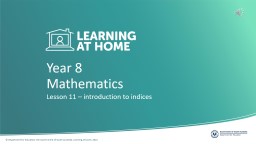

Mathematics You will need A pen pencil and paper A calculator Learning intention To understand that index notation is a way of representing numbers that have repeated factors Warm up ID: 1027837
Download Presentation The PPT/PDF document "Year 8 Lesson 11 – introduction to ind..." is the property of its rightful owner. Permission is granted to download and print the materials on this web site for personal, non-commercial use only, and to display it on your personal computer provided you do not modify the materials and that you retain all copyright notices contained in the materials. By downloading content from our website, you accept the terms of this agreement.
1. Year 8Lesson 11 – introduction to indicesMathematics
2.
3. You will needA pen, pencil and paper.A calculator.
4. Learning intentionTo understand that index notation is a way of representing numbers that have repeated factors.
5. Warm upIf your parents offered you 2 different options for receiving your pocket money, which of the following would you choose?Let’s agree the month in question has 30 days.Option A – $200 per week. Option B – One cent paid on the first day of the month, 2 cents paid on the second day, 4 cents paid on the third day and so on, with the amount received each day doubling until the end of the month.
6. Warm up – solution Option A – $200 per week is $800 plus of the last week $57.A total of $ 857.Option B – This starts with only cents but by doubling each day, did it surprise you that the answer is over $10 million?By day 16, the daily amount was $ 327.68By day 30, the daily amount was $ 5 368 709.12The total is $ 10 737 418.23 Note: There are 28 days in 4 weeks. We need to add 2 more days for the 30-day month. This would be of a week.
7. Index notation represents repeated factorsThis means that the number 1 000 is the product of 10 and 10 and 10.The number 1 000 has three factors of 10.This can be written using index notation:
8. Index form and expanded form vocabularyIndex notation is also called index form:When a number is written as the product of repeated factors, this is called the expanded form:
9. Index form terminologyThe base represents the factor that is being repeated.The index represents the number of times that the factor is repeated. b is the indexa is the base
10. Index notationThe index is a counter. A common mistake is to think that the index is a factor.Consider this example: The number 1 000 does not have a factor of 3.The expanded form shows that the index is a counter: 1 2 3
11. Try theseIdentify the base and the index of: Write the following expressions in index form: 1. 2. 3. .
12. Solution - the base is 6 and the index is 2. - the base is 7 and the index is 5.1. 2. = 3. = x Did you notice that the base is now a letter instead of a number? Now you are thinking algebraically!
13. Try theseWrite the following expressions in expanded form: 1. 2. 3. Evaluate: 4. 5. 6.
14. SolutionsExpanded form:1. = 9 x 9 x 9 x 9 (further evaluated would be 6 561)2. = x x 3. = 3 x 3 x 6 x 6 x 6 Evaluate: 4. = 8 x 8 x 8 = 5125. = 2 x 2 x 2 x 2 x 2 x 2 = 646. = 4 x 4 x 4 x 4 x 4 = 1 024 If you are checking on your calculator, enter 4; push the button, then push 5 and then =
15. BracketsWhat do we do when brackets are included?What does this mean?The base is The index is 3There are 3 factors of x x = Recall our work on directed number to work out the sign.An odd number of negative factors and the result will be negative.
16. Check on your calculator Method 1 Enter 2Change to negative using the +/- buttonPush Ans = Method 2Enter 2Change to negative using the +/- buttonPush Enter 3Push =Ans =
17. Try theseRecord these in expanded form in your workbook and then evaluate using the calculator.1. 2. 3. 4. 5. 6.
18. Solutions1. 2. 3. 4. 5. 6.
19. End of lesson check inRemember our warm-up?Option B didn’t seem like the best option, but surprisingly it was.How can we use indices to assist us to solve this problem?Look at the table that you made:1, 2, 4, 8, 16, 32, 64, 128, ………If 2 is the base, can you spot a pattern with these numbers?
20. Did you notice that the exponent for the base of 2 is one less than the day?DayAmountin ¢Exponent11223448516DayAmountin ¢Exponent11223448516DayAmountin ¢Exponent6327648128925610512DayAmountin ¢Exponent6327648128925610512After 10 days we’ve earnt $10.88 dollars.I wonder when it is a better deal?
21. Finding patternsDid you try to use the pattern?On day 30 we could try using an exponent one less than the day: Enter this into your calculator.Did you get 536 870 912 cents ?This would be $ 5 368 799.12 That is the same as when I doubled all the amounts. To see why it is 1 less than the day, see the pattern in the previous slide.
22. Independent taskComplete level 1 and level 2 of the indices exercise.Record the expanded form in your workbook.If checking with a calculator: enter the basepush enter the exponentpush =
23.
24.